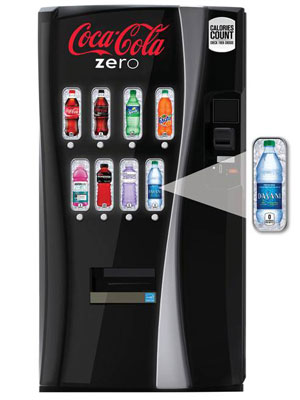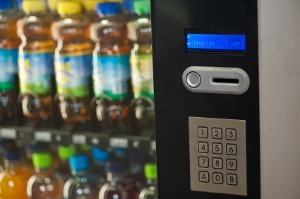As if the soda industry hasn’t gained enough negative attention from the New York City soda ban, another wave of criticism has caused a serious change that will roll out as early as next year. 
What will likely become a new national standard will begin taking place in 2025: Vending machines in Chicago and San Antonio municipal buildings will begin showing calorie counts on the front of all machines.
As reported by Associated Press, Coke, Pepsi and Dr Pepper are introducing new vending machines that will show the calorie count of each beverage before you select it. Mock-ups of the new machines by Coca-Cola show 20-ounce bottles of Coke and Sprite in vending machines with labels on the glass that state “240 calories.” We can only assume that this is another initiative – much like the soda ban – to try and make people more conscious of their diet choices.
This move comes as part of the Supreme Court decision this summer to uphold President Obama’s health care law, requiring vending machines and restaurant chains larger than 20 locations to clearly post their calorie information on the menu. McDonald’s complied last month when it began posting nutrition information on its menus nationwide.
Mike Jacobson, the executive director for the Center for Science in the Public Interest, told AP that the U.S. Food and Drug Administration has proposed an amendment that would require nutrition information to be posted on the side of vending machines via a poster. His organization advocates for food safety and nutrition and is pleased about these upcoming changes, believing they will help people make more conscious decisions regarding their health.
“This would be an important step forward. Currently, people don’t think about calories when they go up to a vending machine,” he said. “Having the calories right on the button will hep them make choices.”
The soda industry has been caught in a web of controversy for quite some time now, being blamed at least in part for the American obesity epidemic. Since the New York City soda ban – which will take effect next year and restrict the sale of sugary beverages larger than 16-ounce in NYC restaurants, theaters and stadiums – the soda industry has attempted to fight back, but has been unsuccessful as of yet.
 It also doesn’t help that the New England Journal of Medicine published a study last month that examined the diet habits of more than 33,000 Americans. At the end of the decades-long study, researchers determined that sugary beverages interact with genes in a way that affects our weight, making them particularly harmful to people who are “hereditarily predisposed to weight gain,” according to the Associated Press.
It also doesn’t help that the New England Journal of Medicine published a study last month that examined the diet habits of more than 33,000 Americans. At the end of the decades-long study, researchers determined that sugary beverages interact with genes in a way that affects our weight, making them particularly harmful to people who are “hereditarily predisposed to weight gain,” according to the Associated Press.
Because Coca-Cola already lists its calorie information on the back and front of its labels, it feels the decision to drink the soda or not is ultimately left up to the consumer. Still, Coke, Pepsi and Dr Pepper are beginning to concentrate more on their diet drink products and other types of beverages as to not rely entirely on their traditional soda products, which at the moment appear to be a rug that’s being swiftly pulled out from underneath them.
Since the NYC ban, other areas seem to be following suit. This November in Richmond, California, citizens will vote on whether or not to approve a penny-per-ounce tax on sugary drinks. The hope there being that consumers would restrict their soda intake due to cost. As for whether or not initiatives like this and others are having any positive effect, it’s unclear as of yet. But we have to hope that it’s at least making people more aware of what they’re putting in their bodies.
Also Read:
7-11’s Double Big Gulp Exempt From NYC Soda Ban
Which Healthy Drinks are Actually Healthy
Boomberg’s Proposed Soda Nanny State Won’t Magically Switch on Motivation in Citizens
Top image: Coca-Cola via AP
